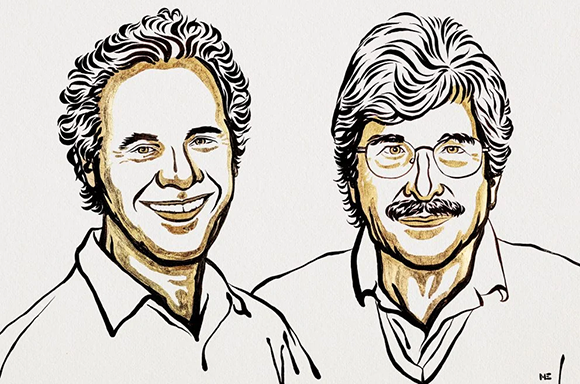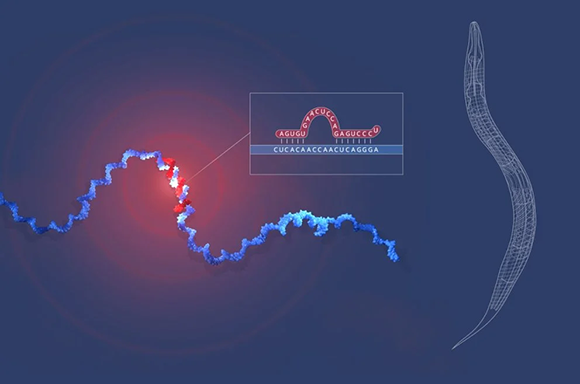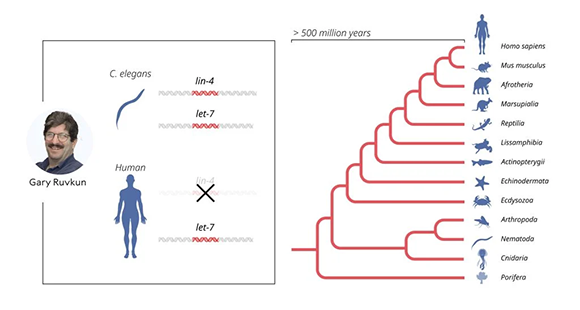The Nobel Prize Committee for Physiology or Medicine at the Karolinska Institute in Stockholm has announced that this year's prize will be awarded to two researchers for their discovery of microRNA. The recipients, Gary Ruvkun and Victor Ambros, identified these small RNA molecules in 1993 and elucidated their role in regulating gene expression.
Our genome, composed of DNA molecules located within the nuclei of our cells, serves as a comprehensive instruction manual for synthesizing all the proteins in our bodies. While almost every cell contains a complete copy of this "manual," every cell produces all the proteins encoded within it.
3 View gallery


A discovery that provided insights into how each cell produces different proteins and how this process is regulated. Ruvkun (right) and Ambros
(Illustration: Nobel Prize Website)
For example, muscle cells produce proteins that form contractile fibers, retinal cells produce proteins that respond to light, nerve cells produce proteins necessary for transmitting electrical signals, among other functions, and so on, across all the different cell types in our bodies. This specialization allows the various cell types to perform their unique functions effectively.
How does a cell determine its specific identity, such as becoming a muscle cell and producing the appropriate proteins? This year's laureates, Victor Ambros and Gary Ruvkun, uncovered one of the mechanisms that ensure each cell produces only the appropriate proteins. The molecules they discovered - small RNA segments known as microRNAs, play a key role in regulating protein production.
What does the worm want?
RNA is a nucleic acid similar in composition to DNA, which makes up our genes. The most familiar type of RNA is messenger RNA (mRNA), which serves as an intermediary between the nucleus, where the DNA resides, and the ribosome, the cellular machinery that synthesizes proteins outside the cell nucleus. A gene is essentially a sequence of instructions for building a protein. To construct the protein, the cell creates an mRNA molecule that copies the gene's instructions through a process called transcription. The ribosome then assembles the protein according to the RNA sequence.
As early as the 1960s, researchers discovered unique proteins capable of influencing the expression levels of other proteins, determining whether and how many of them will be produced in a particular cell. These proteins were named transcription factors because they affect the likelihood that a specific gene will be transcribed into mRNA and ultimately used by the cell to produce the corresponding protein. By attaching to specific locations in the DNA, transcription factors either facilitate or prevent the production of a specific mRNA.
For many years, it was believed that these proteins were the primary regulators of protein production in different cells. However, Ambros and Ruvkun demonstrated that this is not the only mechanism—they discovered microRNA molecules.
3 View gallery


The microRNA sequences of lin-4 (red) and lin-14 (blue) bind to each other, blocking protein production in nematode cells
(Illustration: Ill. Niklas Elmehed © Nobel Prize Outreach)
In the late 1980s, Ambros and Ruvkun were both postdoctoral fellows at the Massachusetts Institute of Technology (MIT) in the lab of Robert Horvitz, who was later awarded the Nobel Prize in Physiology or Medicine in 2002. Ambros, born in California in 1952, arrived there after completing his Ph.D. at nearby Harvard University. Ruvkun, born in New Hampshire in 1953, remained at MIT after earning his Ph.D. there in 1979.
There they conducted research on nematodes, small roundworms of the species C. elegans, which are widely used as model organisms in genetic research, with the aim of identifying genes involved in the production of new cell types during embryonic development. Each focused on a gene affecting developmental timing in the worm. Ambros studied the gene lin-14, noting that it reduced the expression of another gene, lin-14. However, the mechanism behind this reduction was unclear. The most logical hypothesis was that lin-4 produced a transcription factor that suppressed lin-14 expression, but lin-4's sequence was too short and lacked the features necessary for protein production.
At that time, Ruvkun had just established his own lab at Massachusetts General Hospital and continued exploring what suppressed lin-14. He observed that in cells where lin-14 was repressed, its mRNA was still produced but resulted in fewer proteins. This was puzzling: proteins regulating gene expression typically act during transcription, preventing mRNA formation.
If so, could this indicate another repression mechanism that occurs at a later stage? Ruvkun and Ambros compared their findings and discovered that lin-4 and lin-14 produced complementary RNA molecules - meaning they could bind to each other at specific segments.
Unlike DNA, which is structured as a double helix made up of two strands that complement one another—similar to the two sides of a zipper—RNA molecules are single-stranded. The short RNA of lin-4 binds to a specific segment in the RNA of lin-14, forming a double-stranded structure. This structure prevents the ribosome from reading the RNA of lin-14 and synthesizing the corresponding protein, and may also accelerate the degradation of the corresponding mRNA.
3 View gallery


A conserved evolutionary mechanism. The let-7 gene is remarkably similar across a vast range of living creatures, from nematodes to marsupials, and from arthropods to humans
(Illustration: Ill. Niklas Elmehed © Nobel Prize Outreach)
Thus, the two researchers discovered a new type of RNA molecule - microRNA - which are small molecules that do not encode proteins but instead regulate protein synthesis. Unlike protein transcription factors, microRNAs act after the mRNA of their target genes has been produced, preventing the corresponding protein from being synthesized.
This mechanism allows the cell to respond rapidly when necessary, halting the production of proteins for which the messenger RNA has already been transcribed. For example, an organism may no longer need to produce heat-shock proteins that protect DNA from overheating once the temperature has dropped. Their findings were published in two back-to-back articles in 1993.
A conserved mechanism
Initially, the scientific community showed little enthusiasm; many believed this new mechanism might be unique to the studied worms and irrelevant to other organisms. This perspective shifted in 2000 when Ruvkun and his colleagues discovered a new microRNA, which they named let-7. Remarkably, the let-7 gene had remained virtually unchanged over millions of years of evolution and was found in the genomes of numerous animals, not just nematodes.
This already indicated that microRNA represents a widespread regulatory mechanism, sparking significant interest among researchers in these small molecules. Within a few years, hundreds of microRNA genes were identified.
Today, it is understood that this mechanism exists in all multicellular organisms, including animals, plants, and fungi, and is crucial for their development. Researchers estimate that humans have over a thousand microRNAs capable of regulating the expression of thousands of genes. Because microRNA molecules are very small - only 21 to 23 bases in length - a single molecule can often bind to the mRNA of several genes if they contain complementary short sequences.
Research on microRNA has greatly enhanced our understanding of how cells regulate protein production and the consequences of failures in this mechanism. Studies have demonstrated that abnormal microRNA expression can lead to a variety of diseases, including cancer, skeletal disorders, and organ dysfunction. If an excess or deficiency of microRNA is implicated in these conditions, it may be possible to develop treatments targeting these small molecules.
For their collaborative work, Ruvkun and Ambros have received numerous prestigious awards, including the Benjamin Franklin Medal in 2008 and the Dan David Prize, awarded at Tel Aviv University, which Ruvkun shared with biologist Cynthia Kenyon in 2011. In 2014, Ruvkun and Ambros jointly received the Wolf Prize alongside former Israeli researcher Nahum Sonenberg, known for his accurate predictions of Nobel Prize winners in related fields. They were also awarded the prestigious Breakthrough Prize in 2015 and the "March of Dimes" Prize in Developmental Biology in 2016.
Additional announcements
On Tuesday, the Nobel Prize in Physics will be announced, followed by the Nobel Prize in Chemistry on Wednesday. On Thursday, the prize in Literature will be announced, on Friday – the Nobel Peace Prize, and next Monday – the prize in Economic Sciences in memory of Alfred Nobel.
As every year, the prizes will be awarded on December 10, the anniversary of the death of the prize's founder, Swedish inventor Alfred Nobel. The prize amount is 11 million Swedish kronor, a little over one million US dollars, in each category.
Get the Ynetnews app on your smartphone:

